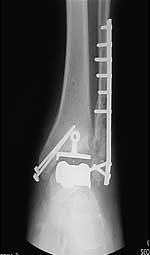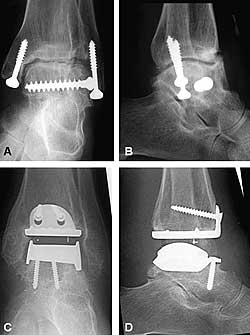How top physicians make the call
Which procedure? Which ankle? Find out how the experts answer these and other crucial questions.
Ankle arthritis is a disease of relatively young and active patients yet treatments are often time-limited. The emergence of improved joint replacement designs for the ankle has stemmed a renewed enthusiasm to find an alternative to fusion for disabling ankle pain. In this two-part series, the world’s experts on ankle arthritis discuss their approach to this challenging clinical problem.
Charles Saltzman, MD
Moderator
| ||||||||||||||||||||||||
Charles Saltzman, MD: How important is function of the human ankle joint? How do patients compensate for loss of motion with the development of ankle arthritis?
Beat Hintermann, MD: The ankle joint forms a functional unit with the subtalar joint that is fundamental for plantigrade, bipedal ambulation. The intact ankle efficiently dissipates the compressive, shear and rotatory forces that are encountered while adapting to weight bearing and ground reaction forces during different phases of the gait cycle. A large articular contact area provides inherent stability under static load, and dynamic stability is afforded by ligamentous support and balanced muscular forces. The mechanical efficiency of the ankle can be inferred from its relative resistance to primary degenerative joint disease. Cartilage and ligament injury or changes in alignment caused by trauma or inflammatory disease may, however, result in articular degeneration.
In most instances, ankle arthritis is associated with loss of motion, particularly of dorsiflexion. The patient typically increases external rotation of his or her affected leg, and he or she reduces the time of single-limb stance, which results in decreased gait efficiency. The patient avoids barefoot walking as he or she feels more comfortable with shoes.
To which extent compensatory dorsi/plantar flexion motion at the subtalar and talonavicular joints is able to compensate for loss of ankle joint motion may depend on several factors: (1) the functional integrity of these joints; and, (2) the condition of the soft tissue structures around the ankle joint complex.
Sandro Giannini, MD: Function of the ankle is particularly important during the stance phase of walking when load has to be transferred from mid- to fore-foot. In level walking about 20° dorsiflexion is necessary. When this motion cannot be achieved at the ankle, it has to be compensated by additional mobility at the other foot joints. These, when not rigid or arthritic, usually allow an overall mobility of about 20º to 25°, therefore enabling the necessary 20° flexion of the shank with respect to the foot. However, our study on patients 20 years after fusion reveals arthritis at the subtalar and mid-tarsal joints when compared to the controlateral foot, though it’s usually not painful. This was found where arthodesis was obtained at ankle neutral position, at 5° external rotation and 5° valgus, and with a slightly posterior location for the talus. On the other hand, development of arthritis at the subtalar and mid-tarsal joints and of pain were found more important in the cases of ankle arthrodesis performed in equinus and inversion of the subtalar joint. Only when the subtalar joint is in its natural position in fact, can this move into both inversion and eversion without overstress which can result in pain and arthritis. In these cases even the omolateral knee was found altered.
Saltzman: What treatments other than fusion or replacement do you offer patients with end-stage ankle arthritis?
Hintermann: Even when the patient presents with end-stage ankle arthritis, I always try first to find a solution other than fusion or replacement. The most important criteria I am looking for is the shape of the articular surfaces. Loss of joint space on loaded X-ray may be critical, but as long as no subchondral cysts have occurred on both side of the tibiotalar joint, there is hope to salvage the ankle for a certain time. Another very important criteria is to what extent the mechanics of the ankle joint is preserved. For instance, a valgus ankle with painful talofibular wear, some depression of the lateral tibial plafond and cyst formation on tibial side (that typically is a floppy ankle with well- preserved motion) will be most promising for supramalleolar varization osteotomy and medial sliding osteotomy of the calcaneus. On the other hand, a painful, rather stiff ankle with anterior extrusion of the talus and large anterior osteophytes that have hindered rolling-gliding movement at the tibiotalar joint thus provoking posterior gaping of the joint will not be a promising situation for any alternative treatment.
In my hand, the surgeon’s armamentarium for alternative treatments in the end-stage ankle arthritis should include arthroscopy or arthrotomy for joint debridement and stimulation of cartilage repair (eg, micro fracturing); supramalleolar and/or calcaneal osteotomies to correct malalignment; ligament reconstruction to stabilize the ankle joint complex; and tendon reconstruction/ transfer to restore muscular function. In practice, success of such measures is sometimes very difficult to estimate. When in doubt, however, I try to promote the patient for a two-stage treatment, of which the first is an attempt to make the ankle as normal as possible. Fusion, and particularly replacement, in such cases then becomes much easier and more successful in a second step, if necessary.
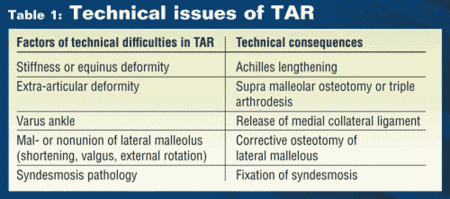 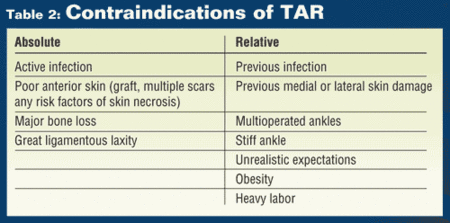 |
| Source: Michel Bonnin |
Giannini: Several options are available for patients with end-stage ankle arthritis. In patients younger than 40 years and not involved in strenuous work activities, a conservative treatment can be indicated, even in severe ankle arthritis. This can be achieved by performing the following techniques:
(1) Joint reconstruction and correction using osteotomies, arthrolysis, etc. in cases where the cartilage is still present in the lateral or medial compartment. The goal is to move the load to the unaffected compartment. For example, a patient presents with severe deformity of the ankle joint in valgus, resulting from poorly corrected previous trauma. In this case it is important to align the joint to reduce the localized stress at the lateral region. This is performed by lengthening the fibula and relevant ankle joint reconstruction. With these techniques, and without joint replacement or allograft transplantation, clinical assessment at six years’ follow-up have demonstrated good results in 80% of cases. In addition this procedure allows future joint replacement or allograft transplantation if necessary.
(2) Where ankle morphology is correct, I suggest arthrodiastasis and arthroscopic arthrolysis and creation of microfractures, ie, creation of small holes through the cartilage in order to stimulate stem cells to repopulate the articulating surface. In these cases, improvement of joint motion and formation of a fibrous cartilage are pursued. Results were initially satisfactory in 50% of the cases, but deterioration of these over time is frequent within the first five years’ follow-up.
(3) When these conservative treatments fail, in patients active and younger than 50 years old, with a correct ankle morphology, an allograft transplantation is indicated.
(4) When fusion or replacement are the only options, if an overall 20º to 25° flexion is achievable between the forefoot and the shank, ie, at the other foot joints, I prefer to perform the former.
Mark Myerson, MD: The alternatives include the following:
(1) an osteoarticular allograft replacement;
(2) a supramalleolar osteotomy; and,
(3) rarely a distraction ankle arthroplasty.
The osteoarticular allograft procedure has been a fascinating addition to our armamentarium and seems to have a short-term (three years) success of 70% in my own experience to date. Revision of this procedure to another graft, an Agility ankle replacement or an arthrodesis will depend upon both patient and anatomic factors. Supramalleolar osteotomy is an excellent alternative when deformity of the distal tibia is present associated with ankle arthritis. Surprisingly, many patients do not require subsequent arthroplasty once the mechanical alignment of the limb has been corrected.
Saltzman: How do you decide if a patient should have an ankle fusion or an ankle replacement?
|
Michel Bonnin, MD: The decision between fusion and prosthesis in case of ankle joint pathology is not yet completely “algorithmic” and depends largely on the experience of the surgeon in the two techniques. At the beginning of my experience in total ankle replacement (TAR) in 1993, I was very selective in my indications and did TAR only in “optimal” cases: rheumatoid arthritis or OA without great deformity, ligamentous instability or major stiffness. With time, I observed that functional results and patient satisfaction rates were better with TAR than with fusion and I became more confident in the technique of TAR. Progressively I extended my indications to more difficult cases: patients with extra-articular deformity requiring additional procedures such as subtalar fusion triple arthodesis or supramalleolar tibial osteotomy; patients with stiff equinus ankles, sometimes with previous fusion; and patients with OA due to chronic ankle instability with varus deformity. These cases need careful preoperative planning, with full leg X-ray, CT scan and sometimes dynamic X-ray, to assess the difficulties and prepare the technical solutions (Table 1).
Michael Coughlin, MD: Evaluating the patient and his education and explaining the pros and cons of ankle arthrodesis vs. ankle replacement is an important process. Typically the age of a patient and activity level are very important concerns. Excess weight (greater than 250 pounds) is a contraindication. Relative contraindications are the history of a prior infection, the severity of deformity, and the presence of ankle ligamentous instability. Where any of these factors eliminate consideration of an ankle replacement, an ankle arthrodesis is often alternative choice.
Myerson: Perhaps the most important factor in decision-making is the ability of the patient to tolerate and accept failure. We have approached ankle replacement, for example, with the traditional indications including age, weight and activity level, but I think that this is not appropriate as an absolute means of decision making. The older patient who may otherwise be a suitable candidate for an ankle replacement, may also want to “get on with his or her life,” without the aggravation and possible significant implications of revision surgery.
Saltzman: How do you typically perform an ankle fusion and why?
Hintermann: Despite the high level of satisfaction with the results of ankle arthrodesis, it is a salvage procedure with limitations. Thus I try to preserve the anatomy of the hindfoot as much as possible when performing an ankle fusion. I use an anterior approach to expose and debride the joint, and then use two plates to achieve ankle fusion. This technique preserves the ankle joint anatomy as much as possible, which will potentially allow the fusion to be taken apart for ankle arthroplasty when painful degeneration at the subtalar and/or transverse tarsal joints makes further fusion necessary.
Bonnin: My technique depends on the reason why a TAR is contraindicated. If there is no bone deformity but only skin problems, I prefer doing an arthroscopic fusion. I use the technique I described in the French review of orthopedic surgery in 1995 (Rev. Chir. Orthop., 1995, 81, p.128 – 135). I use two cannulated screws for fixation (one from fibula to talus and one from tibia to talus) introduced with image intensifier control.
In case of varus or valgus deformity >10°, or in case of bone loss, I prefer doing an open procedure via an anterior approach. Bone cuts are done with an oscillating saw, guided by the extra-medullary guide of the TAR, to improve bone cut accuracy. Fixation is then done with two anterior staple.
Postoperatively, after an ankle fusion the patient wear a below knee cast, without weight-bearing during 45 days and then with full weight-bearing for 45 days.
Coughlin: My typical approach is through a lateral incision with the patient in a lateral decubitus position. The fibula is taken down and internal fixation is placed from distal to proximal from the sinus tarsi, and also from the posterior malleolus through the axis of the talus. The fibula is usually replaced and fixed with two bicortical screws. This technique is used because it ensures proper alignment and in my hands has a high rate of success. A criticism of this technique would be that the ankle fusion is “permanent.” I explain to all patients that I have no plans to take down an ankle fusion at a later date and perform an ankle arthroplasty.
Myerson: For the past 15 years, I have used the “mini-arthrotomy” approach to ankle arthrodesis. The success of arthroscopic arthrodesis encouraged me to find a suitable alternative with a similar rate of arthrodesis without the technical difficulties encountered with arthroscopic arthrodesis. Initially, I limited the mini-arthrotomy approach to well- aligned joints, with minimal bone loss, but I now use this for all arthrodesis procedures, including avascular necrosis and deformity. Minimal periosteal stripping, preservation of the fibula and the surrounding blood supply and rigid fixation with cannulated 6.5-mm screws seem to be the key to the success of this procedure.
Saltzman: What do you tell patients about the risks of these surgeries? How long and difficult is the typical postsurgical convalescence period?
Hintermann: The outcome of the performed ankle fusion or total ankle prosthesis depend highly on the evaluation and correct management of potential pre- or intraoperative risk factors. Heavy smoking, neuroarthropathic degenerative joint disease (Charcot’s ankle), active or recent infection, significant avascular necrosis of the talus, and a compromised soft-tissue envelope around the ankle may be high- risk factors for successful isolated tibiotalar fusion, and ankle replacement may not considered at all for these entities. While ankle fusion may be successful, ankle replacement may be critical for neurological dysfunction of the foot or leg, severe non-reconstructable malalignment (20° or greater varus or valgus deformity), or ligamentous instability (for example, chronic ankle instability) of the ankle or hindfoot.
When discussing arthrodesis vs. total ankle arthroplasty with a younger patient who suffers from painful end-stage ankle arthritis, I clearly explain that that total ankle arthroplasty may be a viable option for an initial period of time. If the implant fails over time, and revision arthroplasty is not feasible at that time, then conversion to ankle arthrodesis can be performed. This “two-stage approach” to ankle arthrodesis may effectively preserve the adjacent joints from overuse and secondary osteoarthrosis. Therefore, I use only total ankle implants that require minimal bone resection, thereby saving bone for further revisions or later isolated ankle joint fusion.
As rehabilitation of the diseased ankle after replacement takes much longer than after knee or hip replacement I always emphasize that it will take about two years until the final result will be achieved. This is particularly true for posttraumatic osteoarthrosis and ankles that have undergone multiple surgical procedures before, where the soft tissue mantle around the ankle is significantly damaged.
Bonnin: During consultation, I spend a long time explaining to the patient the respective advantages and disadvantages of the two techniques so that the patient can make the decision and choose the technique himself (Table 3). The important information is to explain that a TAR is not a “normal ankle of somebody twenty years old,” especially in term of ROM, pain and sport activities. Many patients eligible to TAR are active adults (post traumatic OA) and can have unrealistic expectations. Literally I say to the patient that choosing a TAR instead of a fusion means choosing to have a better functional result if everything goes well but it also mean taking the risk of a failure.
Postoperatively, the patient is immobilized in a below the knee cast for 45 days. Full weight-bearing is allowed immediately or after three weeks in case of Achilles lengthening. I recommend the use of a post op cast for two main reasons: to protect the skin and to prevent any equinus position. This point is critical as the functional prognosis in TAR depends largely on the possibility to recover a proper dorsiflexion.
After removal of the cast, the patient is allowed to walk with normal sport shoes without any brace or orthoses. Rehabilitation is then limited to walking training, cycling and recovery of ROM, especially for dorsiflexion. Proprioceptive work or muscular training is prohibited during the three first months and is allowed only when the ankle is completely pain free.
The speed of recovery depends mainly on the environment of the ankle joint. If the problem was limited to cartilage degeneration without any stiffness, malalignment or previous surgery, the rehabilitation is easy and needs only two or three months. In case of preoperative stiffness, associated triple arthrodesis, Achilles lengthening or previous surgery the rehabilitation is longer and more difficult.
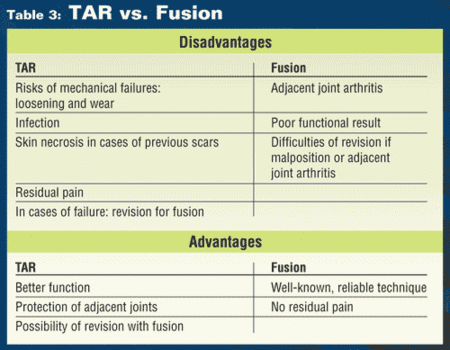 |
| Source: Michel Bonnin |
Coughlin: For patients undergoing ankle arthrodesis or total ankle arthroplasty I have a frank discussion with them about the possibilities of success and failure. Probably the most significant complication is infection and may lead in either situation to a below-the-knee amputation. That risk, as well as the possible need for a free flap, are the two major complications I cover. For ankle arthrodesis malunion, delayed union, nonunion, and failure of hardware are considerations. For total ankle arthroplasty subsidence, polyethylene wear, gradual development of malalignment, and ankle instability are all complications that should be discussed as well.
The post surgical convalescence for total ankle is decided easier than following an arthrodesis. Weight bearing is started much sooner and immobilization is typically used in order to insure wound healing. For an ankle arthrodesis immobilization of twelve weeks is a standard, six weeks of the period of which is nonweight-bearing.
Saltzman: What type of ankle replacement do you use and why?
Hintermann: I use the Hintegra Total Ankle Prosthesis (Newdeal; Lyon, France) that is a non-constrained, three-component system that provides inversion/eversion stability. Axial rotation and normal flexion/extension mobility are provided by a mobile-bearing element. Motion limits are dependent on natural soft-tissue constraints: no mechanical prosthetic motion constraints are imposed for any ankle movement with this device. The Hintegra ankle uses all available bone surface for support. The anatomically shaped, flat tibial and talar components essentially resurface the tibia and talar dome, respectively, and wings hemiprosthetically replace degenerate medial and lateral facets (a potential source of pain and impingement). No more than 2 mm to 3 mm of bone removal on each side of the joint is necessary to insert the tibial and talar components.
On the tibial side, most importantly, the bony architecture remains intact, and, in particular, the anterior cortex is preserved. Perfect apposition with the hard subchondral bone is achieved by the flat resection of the bone and the flat surface of the component. Primary stability for coronal plane motion is provided by two screws inserted into the anterior shield in the upper part of oval holes so that the settling process of the component is not hindered by axial loading. On the talar side, additional anterior support is provided by a shield, and pressfit is provided by the slightly curved wings. Two pegs facilitate the insertion of the talar component and provide additional stability, particularly against anterior-posterior translation (additional screw fixation is optional). Another advantage of this concept is the instrumentation that allows reliable component implantation.
In the last five years, I performed more than 400 replacements with the Hintegra ankle. The learning curve was rather long as some adjustments had to be performed, and I needed some time to understand “ligament balancing” in ankle replacement in more detail. However, since then, I am extremely satisfied with the results, and my patients do very well. The revision rate has also dropped to less than 2% even though with our increased experience we were able to take on more complex cases may have been considered for ankle replacement.
Giannini: We are now using the novel Box total ankle prosthesis by Finsbury Instrument Ltd. Clinical trials are in progress here at Rizzoli and in several hospitals in north Italy. This new design results from a long investigation conducted in our research labs, aimed at restoring original joint mobility while maintaining full congruence at the prosthetic articular surfaces.
The guiding and limiting actions of the ligaments seem to have been finally well understood, and recovered in the ankle joint replaced by the Box. Implantation in six anatomical preparations and 22 patients has been very encouraging so far. The motion of the mobile meniscus has been as expected and predicted by the computer models in all these cases. Soon, clinical and biomechanical results at two years follow-up will reveal if any important step forward has been achieved in TAR.
|
Bonnin: I use the SALTO prosthesis that belongs to the so-called “third generation” group of TAR. These “third- generation” designs are the result of three major improvements in comparison with older ones:
(1) mobile bearings, which reduce stresses on the fixation devices;
(2) cementless fixation, which preserves a maximum amount of bone; and,
(3) minimal bone resections, which allow reliable anchoring in dense bone.
In this group the SALTO prosthesis has some specificities, which are as follows:
(1) The quality of the fixation is optimised: The primary fixation is ensured by closely matching the components to the bone, and enhancing fixation with pegs. On the tibial side, the cylindrical peg provides good compression of the metal base plate onto the distal tibial cut surface at impaction, while eliminating the need for a tibial window. The secondary fixation is provided by bone ingrowth into a dual coating HA coating over a 200-µm thick layer of plasma-sprayed Ti.
(2) The anatomic design — the success of a total ankle prosthesis depends mainly on restoring normal or nearly normal ankle kinematics, which requires optimal component positioning and an anatomical bearing surface design. In the SALTO prosthesis, the talar component has an anatomic shape: it is broader anteriorly than posteriorly, and has two different radii of curvature, medially and laterally, that restore near normal joint kinematics.
(3) The instrumentation provides accurate, reproducible bone cuts and implant positioning. The technique is based on the use of an extramedullary guide which enables the surgeon to perform the different adjustments step by step. Talar bone cuts are done with an oscillating saw, which ensures closer bone-implant contact than simple decortication of the convex surface. Using two instead of three talar dome cuts simplifies the technique, results in tight component fit and is much more bone-preserving. The technique based on the use of an extramedullary guide enables the surgeon to perform the different adjustments step by step and the talar cuts are linked with tibial cuts.
Coughlin: As one of the two chief investigators for the Scandinavian Total Ankle, this is the ankle replacement that I have the most experience with. There has been a substantial experience over the last 15 years in Europe. Nonetheless, over the last five years we have had significant experience with this ankle in the United States both prior to and following the pivotal FDA study. Specifically, the advantages of this ankle are that it has a mobile bearing meniscus and allows a minimal of bony resection, which in many cases is advantageous should an ankle replacement fail. Arthrodesis is simpler to perform.
Myerson: I use the Agility (DePuy) ankle replacement. When I started with ankle replacement in 1995, I visited with Dr. Frank Alvine in Sioux Falls, S.D., and was encouraged by his results. At that time, there were no viable alternative prostheses available for implantation, and I have continued to use this prosthesis. I think that there is a significant learning curve to ankle replacement, regardless of the prosthesis used. There are, of course, biomechanical advantages to the Agility replacement, and having mastered some of the difficulties with this prosthesis, it is unlikely that I will change to another, regardless of its’ availability.
Dr. Bonnin has a financial interest in a product mentioned in this round table.
Editor’s note: Read the May issue of Orthopedics Today for part two of this virtual round table discussion on ankle fusion vs. total ankle replacement.

![Charles Saltzman, MD [photo]](/~/media/images/news/print/orthopedics-today/2005/04_april/saltzman_70_90_2951.jpg) Charles Saltzman, MD
Charles Saltzman, MD![Beat Hintermann, MD [photo]](/~/media/images/news/print/orthopedics-today/2005/04_april/hinterman_70_90_2951.jpg)
![Sandro Giannini, MD [photo]](/~/media/images/news/print/orthopedics-today/2005/04_april/giannini_70_90_2951.jpg)
![Mark Myerson, MD [photo]](/~/media/images/news/print/orthopedics-today/2005/04_april/myerson_70_90_2951.jpg)
![Michel Bonnin, MD [photo]](/~/media/images/news/print/orthopedics-today/2005/04_april/bonnin_70_90_2951.jpg)
![Michael Coughlin, MD [photo]](/~/media/images/news/online/orthopedics/2007/04_april/25/coughlin_70_90_21592.jpg)
